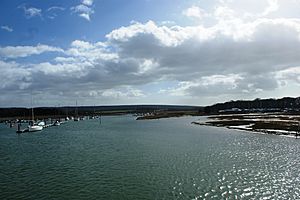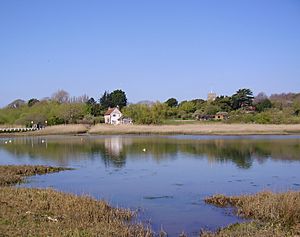Western Yar facts for kids
Quick facts for kids Western Yar |
|
|---|---|

The Western Yar from the Yar Bridge at Yarmouth.
|
|
| Physical characteristics | |
| Main source | Freshwater |
| River mouth | Solent |
The River Yar is a river on the Isle of Wight, England. It starts near the beach at Freshwater Bay, on the south coast. From there, it flows just a few miles north to Yarmouth, where it joins the sea channel called the Solent. Most of this river is a special type of river mouth called a tidal estuary, where fresh river water mixes with salty sea water.
The River Yar is one of two rivers with the same name on the Isle of Wight. To tell them apart, this one is often called the Western Yar.
Exploring the Western Yar Estuary
The part of the River Yar that flows into the sea, known as its estuary, stretches from Freshwater to Yarmouth. This area is part of the island's Area of Outstanding Natural Beauty. This means it's a special place with beautiful landscapes and important wildlife.
What Makes the Estuary Special?
The estuary is home to many different natural areas, called habitats. These include:
- Saltmarshes: Grassy areas that get covered by seawater at high tide.
- Reedbeds: Areas filled with tall, grass-like plants called reeds.
- Mud flats: Flat, muddy areas that are exposed at low tide.
- Sand dunes: Hills of sand formed by the wind, often found near beaches.
These habitats are perfect for a huge variety of wildlife. Many birds, especially waterfowl (like ducks and geese) and waders (birds that feed in shallow water), come here to spend the winter.
Protecting the Yar's Nature
The Yar estuary is so important that it has a special protected status. It is a 132.4-hectare biological Site of Special Scientific Interest (SSSI). This means the area is protected by law because of its unique plants, animals, or geology.
The upper parts of the river are also protected as an SSSI, called Freshwater Marshes. A large part of Freshwater Marshes is also a Local Nature Reserve known as Afton Marshes. These protections help make sure the river and its wildlife stay healthy for a long time.


